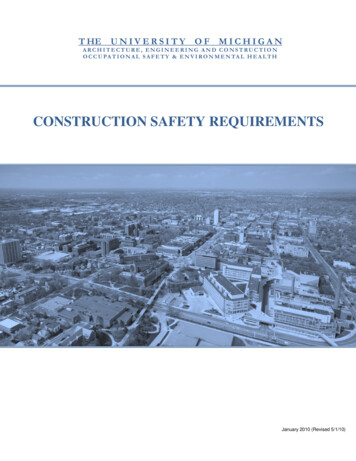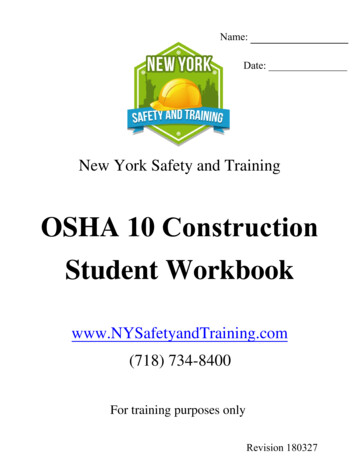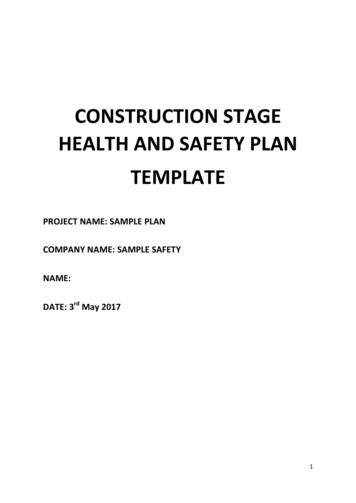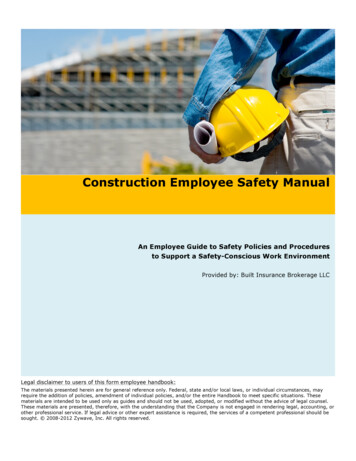
Transcription
T HE U N I V E R S I T Y O FMICHIGANARCHITECTURE, ENGINEERING AND CONSTRUCTIONO C C U PA T I O N A L S A F E T Y & E N V I R O N M E N TA L H E A L T HCONSTRUCTION SAFETY REQUIREMENTSJanuary 2010 (Revised 5/1/10)
ContentsI.DEFINITIONS . 3II. INTRODUCTION . 4III. SAFETY MANAGEMENT SYSTEM . 5A.B.C.D.E.F.Contractor Prequalification . 5Contractor Safety Representatives . 6Monthly Safety Reports. 7Communication . 7Job Safety Board . 8Project-Specific Safety Plan Overview . 8IV. UNIVERSITY ADDITIONS FOR PROJECT-SPECIFIC SAFETY PLAN. untability Plan . 10Audits/Inspections . 10Cell Phone Usage . 10Crane Safety and Rigging. 10Electric – Temporary . 12Emergency Action Plan . 12Environmental Health and Safety. 13Equipment Safety . 16Fall Protection . 16Fire Prevention and Protection . 16Housekeeping . 18Job Hazard Analysis (JHA) . 19Personal Protective Equipment (PPE) . 19Potentially hazardous exhaust systems. 19Protection of the Public . 19Recordkeeping and Incident Reporting . 20Rooftop Access. 20Smoking. 21Substance Abuse Policy . 21Temporary Elevators . 21Utility Tunnel Safety . 22Visitors . 22V. APPENDICESAppendix A:Appendix B:Appendix C:Appendix D:Monthly Safety Report .23Crane - Job Safety Analysis Form .25Hot Work Permit .30Injury Illness Report Form – MIOSHA 301 .312 of 31
I.DEFINITIONSGeneral Contractor/Construction Manager: The party named in the contract agreement who willexecute the Work and who shall be responsible for the proper completion of the Project.DART: Days Away from Work, Restriction of duty, or Transfer. This term is used by MIOSHAand the Bureau of Labor Statistics for tracking and reporting of these types of injuries.Document: University of Michigan Construction Safety Requirements.EMR: Worker’s Compensation Experience Modification Rate.Hazardous Materials: Any pollutant, hazardous or toxic substance, waste or material, including oilproducts, mold, asbestos, asbestos-containing materials, lead, lead-containing materials, ureaformaldehyde foam insulation, transformers or other equipment which contains dielectricfluid-containing polychlorinated biphenyls, flammable explosives, radioactive materials or othermaterial or substance designated or regulated as hazardous or as a toxic substance or waste, pollutant orcontaminant under Regulations.Job Hazard Analysis (JHA): A safety analysis to be submitted by subcontractors/trade contractorsprior to the commencement of work on a Project. Also known as Job Safety Analysis or Pre-taskAnalysis.MIOSHA: Michigan Occupational Safety and Health Administration.OSEH: The University of Michigan Occupational Safety and Environmental Health Department.Owner: The Regents of The University of Michigan, a Constitutional Corporation having itsprincipal offices in Ann Arbor, Michigan, represented on the Project by the Owner’s Representative.Owner’s Representative: The individual designated in writing by the Owner to receive allcommunication under the Contract Documents and with the authority to bind the Owner with respect todecisions made and actions taken pursuant to the Contract Documents.Plan/Contractor’s Project-Specific Safety Plan: The Plan created by the Contractor pursuant to therequirements of its Contract with U-M outlining how the Contractor intends to address safety on theProject, and meet the Contractor’s responsibilities to provide a safe work environment and to aid indeveloping a program to eliminate accidents, injuries and property damage. It is the Contractor’sresponsibility to ensure compliance with all applicable MIOSHA standards.Project: The building or facility, improvement, alteration, addition or repair, the construction forwhich is contemplated under the Contract Documents.Project Site: Those areas indicated in the Contract Documents where the Work is to be performed.This includes premises owned by U-M as described in the Contract between U-M and Contractorand/or areas contiguous thereto, including any Project Site set up by U-M for use exclusively forstorage of material or equipment or for on-Project Site fabrication of material to be used on the ProjectSite, including temporary locations.3 of 31
Project Team: The Owner’s Representative, Architect and Contractor, together with such otherpersons or entities selected by the Project Team and whose management, responsibility andcollaboration are required for the Project’s success.Subcontractor/Trade Contractor: Where “subcontractor/trade contractors” is referenced, includeall trade contractors, subcontractors and lower tier subcontractors engaged to perform work on theProject.University of Michigan: References in this Document to “University of Michigan”, “U-M”, or the“campus” all include the entire Ann Arbor Campus, Flint Campus and Dearborn Campus, and otherproperties owned or controlled by University of Michigan.Work: The construction required by the Contract Documents whether completed or partiallycompleted, performed by the General Contractor/Construction Manager, Subcontractor/TradeContractor, or other lower tiered subcontractors. Work refers to the furnishing of labor, furnishingand incorporating materials and equipment into the construction and providing any service required bythe Contract Documents to fulfill the General Contractor’s/Construction Manager’s obligation tocomplete the Project.II.INTRODUCTIONThe University of Michigan endeavors to maintain safe working conditions for its staff and a safe andhealthy environment for its students and visitors. This also includes our construction contractors andtheir respective workforces. Safety is an essential component of construction work at the Universityof Michigan. It is a key contractual responsibility for those managing and performing such work andan important determinant of overall Project success. The University of Michigan believes that effectivecontractor safety programs enhance projects by assisting contractors to systematically identify andevaluate anticipated hazards and establish controls in advance of actual work. While the obviouspurpose of a contractor safety program is to reduce on-the-job injuries and illnesses to the greatestextent possible and to ensure compliance with all workplace safety standards, the interactionsdeveloped through these programs can also bring collateral benefits in the form of improvedcommunication, documentation, and cost savings.University of Michigan Construction Safety GoalUniversity of Michigan’s immediate goal is for contractors to work injury and illness free on each ofthe projects they perform at U-M. Our goal is zero accidents on construction projects.Scope of DocumentThe contractor is responsible for the safety of its employees, and the University of Michigan iscommitted to helping the Contractor meet its goals of a safe, healthy and productive work site. TheUniversity provides this document to help contractors provide a safe environment for their employeesand everyone else who visits the project site. The applicability of this document is for all constructionprojects administered through U-M Architecture, Engineering and Construction (AEC). Thecontractor nevertheless remains solely responsible for the safety of all persons and property, and musttake whatever steps may be necessary or appropriate to assure that safety. The contractor is solelyresponsible for the development and implementation of their own safety program. This document4 of 31
provides contractors with U-M’s specific requirements for incorporation into their safety programsimplemented pursuant to their contracts for work to be performed at U-M. This document is notdesigned to address every possible environmental, safety, or health issue. No specific requirementsgiven herein are intended to limit, replace or supersede applicable provisions of federal, state, andmunicipal safety laws. The requirements in this document apply to all new construction, renovation,alteration, and demolition projects conducted by general contractors/construction managers,subcontractor/trade contractors and their respective employees.The contractor shall comply with applicable provisions of federal, state, and municipal safety lawsand building codes. This document outlines contractual requirements as well as suggests the rolesand responsibilities various parties have for construction safety, identifies key facility resources,outlines minimum safe work requirements, and provides guidelines for responding to potentialemergencies. This document, however, does not relieve any contractor of its obligations to (1) controlthe means and methods by which it and its employees, subcontractor/trade contractors and agentsperform work or services at U-M; (2) independently ascertain what health and safety practices areappropriate and necessary for the performance of such Work; and (3) develop, implement and enforcea comprehensive health and safety program appropriate for the Work or services performed thatcomplies with all rules, regulations and industry standards, including permits, governing the contractorand the Project.In various places, this document requires contractors to develop and administer plans for safety, fireprevention and other environmental, health and safety issues on a Project. The U-M shall have theright, but not the obligation, to review and comment on any such plan and any amendments to it. Thecontractor shall carefully consider all U-M comments on the Plan, but the contractor bears finalresponsibility for scope, detail, implementation, enforcement and administration of all such plans.Neither any comments offered by U-M nor the failure of U-M to offer any comments shall in any wayreduce the contractor’s responsibility for safety.The provisions set forth in this document are intended to either be in addition to or clarify therequirements of the contract documents. This document shall never be interpreted as lessening orsuperseding any requirement set forth in the contract documents. Additional site-specific safetyrequirements may be mandated under the contract “Special Conditions”.III.SAFETY MANAGEMENT SYSTEMEach project shall have a safety management system in place that outlines the policies, processes,instruction, and documentation that will serve to establish the culture of safety and understanding forall tiers involved on the project. The following components shall be part of the systematic approach:A.Contractor PrequalificationU-M has established requirements pertaining to contractor safety. U-M requires an EMR of 1.0 orless and also evaluates other safety performance criteria. Information and prequalification forms canbe found at http://www.aec.bf.umich.edu/. The contractor is responsible to prequalify allsubcontractors/trade contractors engaged on a project per their own written prequalification process.5 of 31
B.Contractor Safety RepresentativesFor all projects, a designated project safety representative or project safety manager shall be on site atall times while work is being performed. The minimum qualifications for the project safetyrepresentative and project safety manager are as follows:Project Safety RepresentativeThe designated project safety representative shall have completed an authorized 30 hour OSHAConstruction Safety Course and have current CPR/First Aid Training from a nationally recognizedprogram. Except in instances where the contract calls for a dedicated project safety manager (seebelow), this employee may also function as a superintendent, foreman or crew leader on the Project.The general contractor/construction manager must identify their onsite project safety representativeprior to the commencement of any work and provide evidence to U-M this employee meets theminimum requirement listed above. No work is to be performed on site when a project safetyrepresentative is not present. The general contractor/construction manager shall provide notificationto U-M of any changes in the designation of a project safety representative.In addition to the general contractor’s/construction manager’s project safety representative, a projectsafety representative shall be assigned to each subcontractor/trade contractor crew requiring thesupervision of a foreman or crew leader. This project safety representative will typically be anemployee of the subcontractor/trade contractor. This employee may also function as thesubcontractor/trade contractor’s superintendent, foreman, or crew leader, on the project.Project Safety ManagerA dedicated, full-time project safety manager may be a contractual requirement on large projects orprojects deemed by U-M to be particularly high risk. This would be in lieu of a generalcontractor/construction manager’s project safety representative. This person shall not have any otherassigned duties. The following are the minimum qualifications and selection criteria for the projectsafety manager: Training Requirements of:- Certified Safety Professional (CSP), Certified Industrial Hygienist (CIH), or- Have completed an authorized 30 hour OSHA Construction Safety Course and possess theadditional training, years of experience, and skills necessary to thoroughly understand thehealth and safety hazards and controls for large construction projects, including the fullscope of the specific Work; Have a successful interview with the Owner’s Representative, Occupational Safety andEnvironmental Health (OSEH), and/or other member(s) of the project team.A detailed job description that outlines the responsibilities and authority for the project safetyrepresentative and/or project safety manager shall be made available upon request. The jobdescription should include the following items, as applicable: Enforce compliance withproject-specific safety plan, project-specific orientation, job hazard analyses (JHA’s), accidentinvestigation, attendance at progress meetings, documented safety inspections. The University ofMichigan reserves the right to request that the general contractor/construction manager replace anysafety representative at any time during the project.6 of 31
C.Monthly Safety ReportsThe general contractor/construction manager shall prepare and submit a project-specific monthlysafety report to the Owner’s Representative by the 15th of each month (Appendix A). The form shouldbe signed by the contractor project director/manager and contractor superintendent. This is inaddition to the normal reporting and recordkeeping requirements on the Project listed in Section IV.The monthly safety report shall report current month data, year-to-date data, and project to-date datafor the following items: Number of cases and rates for OSHA Recordable incidents, lost work incidents, DARTincidents and near misses.Average daily number of employees and total hours worked by employees.Project safety activity counts for orientations completed, safety huddles/talks, safetyinspections, disciplinary actions, and fire, spill or other emergencies.Number of OSHA recordable injuries as they fall into the category of falls, electrical, struckby, or struck against and the number of illnesses. More detail regarding the recordableincidents is also requested in a summary paragraph form.Number of MIOSHA Citations received on the project broken down by serious, repeat andwillful.D.CommunicationOrientationThe general contractor/construction manager is required to develop a project-specific safetyorientation for all workers, including subcontractors/trade contractors and other individualsperforming work at the site such as U-M Plant Operations personnel. Orientation training shalladdress all components identified in the project-specific plan. The orientation must be completedprior to allowing workers to start on-site. On University of Michigan Health Systems (UMHS)projects, personnel may also be required to attend a UMHS orientation. See the visitor informationlocated under Section IV for requirements regarding visitors and tours.Pre-Construction Safety MeetingPrior to starting Work on any U-M project, the general contractor/construction manager must lead apre-construction safety meeting. The meeting shall include as attendees the generalcontractor/construction manager’s field supervisory staff that will be primarily responsible formanagement of workers and crafts, supervisory personnel from major subcontractors/tradecontractors, and the owner’s representative and the U-M OSEH Department. The primary purpose ofthis meeting is to introduce the general contractor’s/construction manager’s supervisory personnel,subcontractors/trade contractors and owner’s representative to the general contractor’s/constructionmanager’s project-specific safety plan and to have the general contractor/construction managerdemonstrate an understanding of the project conditions and safety requirements.A schedule for regular progress meetings shall be established at this meeting. Since safety is a criticalpart of this meeting, the project safety representative or project safety manager shall attend thesemeetings.7 of 31
Project Safety CommunicationThe general contractor/construction manager is required to implement a policy for ongoing safetycommunication during the Project. It is essential to keep safety in the forefront bycommunicating the importance of safety on a regular basis. This may be accomplished though theuse of daily safety huddles, toolbox meetings, and/or other such initiatives.All personnel shall be informed of the U-M Construction Safety Tipline as an avenue toanonymously report non-emergency safety related issues. The number for the Tipline is800-863-1355 or 734-763-9180 or text messages can be sent to 37791. Issues will be followed upby the U-M OSEH department during normal business hours.University of Michigan Community Meeting(s)At the request of the owner’s representative, the general contractor/construction manager may berequired to participate in various meetings with representatives of the larger U-M community or otherinterested parties in order to address sensitive populations or areas on campus. Any such meetings willbe led by the owner’s representative and may also involve other affiliated university departments. Atsuch meetings, the general contractor/construction manager may be asked to respond to safety andoperational issues that arise on projects and may be expected to (1) provide brief descriptions of theirplanned work; and (2) provide other information as may be appropriate to the project.E.Job Safety BoardThe general contractor/construction manager shall post and maintain a job safety board at the projectsite in a conspicuous location that is accessible to the subcontractors/trade contractors, workers andother personnel arriving at or entering the project site. The general contractor/construction managershall notify all persons working on the project site of the location of the job safety board. At aminimum, the Board shall provide the following information and items: Basic project information MIOSHA poster General contractor/construction manager names and contact numbers for key personnel andsubcontractors/trade contractors Emergency procedures and contact numbers Location where project-specific plan can be found Location of project-related material safety data sheets Shutdown notices and posting of other activities requiring coordination Notices for upcoming job and safety meetings Location of accident report forms Monthly summary of recordable injuries/illnesses, lost-time and total recordable rates, nearmiss incidents Hot Work permit kit Location of first aid stationF.Project-Specific Safety Plan OverviewGeneral contractors/construction managers must develop, communicate, and implement a writtenproject-specific safety plan (“Plan”). The goal of the Plan is to assist general contractors/constructionmanagers in meeting their responsibilities to provide a safe work environment and to aid in developinga program to eliminate accidents, injuries, and property damage.8 of 31
Although the specific elements of each Plan will vary by the Work or services to be provided andproject size, complexity, and location, at a minimum, the Plan must adequately address therequirements in Section IV of this Document, if applicable to the general contractor’s/constructionmanager’s work. The Plan must also identify foreseeable project-specific hazards and list the generalcontractor’s/construction manager’s mitigation and control of such hazards. As the Plan is meant tobe a living document, general contractors/construction managers are to amend the Plan to address anynew hazards that were not addressed in the initial Plan but are later identified during the course ofperforming work at the U-M. This Plan is required to be followed by all subcontractor/tradecontractors as well.The following list of elements of a project-specific safety plan is provided to assist the generalcontractor/construction manager. The Plan may include only elements that are necessary for the givenproject and do not need to comply with this particular format. AccountabilityAudits/InspectionsCell phone usageCommunicationCompetent personConcrete/masonryConfined spacesCranes and hoistsDemolitionElectrical safetyEnvironmental and Occupational HealthEquipment safetyExcavation and trenchingFall protectionFire prevention and protectionHazard communicationHousekeepingIncident management and prevention- emergency action planJob hazard analysis (JHA)LaddersMaterial handlingMoisture control and mold preventionPersonal protective equipment (PPE)Pest managementPublic protectionRecordkeeping and reportingSafety meetingsScaffoldingSigns, signals and barricadesSteel erectionSubstance abuse policy9 of 31
IV.Temporary elevator usageTool safetyTrainingVisitor policyWelding/cuttingUNIVERSITY ADDITIONS FOR PROJECT-SPECIFIC SAFETY PLANA.Accountability PlanAn accountability plan shall be developed, communicated, and implemented for the project. Thisplan shall include disciplinary procedures to be utilized for noncompliance with safety requirements.Violations may result in work stoppage and progressive enforcement action pursuant to the terms ofthe contactor’s contract with U-M. If violations are severe or repetitive, the general contractor/construction manager or subcontractor/trade contractor may be prohibited from working at U-M in thefuture.B.Audits/InspectionsThe general contractor/construction manager shall conduct and document regular safety inspections(minimum of informal daily and formal weekly) of their work areas and practices, and those of theirsubcontractors/trade contractors. Documentation of inspections shall be readily available for reviewon the project site. The general contractor/construction manager will immediately correct anyhazardous or otherwise noncompliant conditions identified and maintain documentation of thecorrective action. In addition to the regular inspections indicated above, a documented auditconducted by corporate or regional safety representatives shall be done at least once per month.C.Cell Phone UsageThe general contractor/construction manager shall have a cell phone policy with an objective ofprohibiting jobsite cell phone usage except as necessary for the performance of work tasks. At aminimum, the policy shall address the following: Designated “safe zones” for general use of cell phones by workers A “No Walking While Talking” policy for work task related cell phone usage When a cell phone is part of an operation requiring a Job Hazard Analysis, the use of the cellphone shall be specifically detailed in the analysis.The site cell phone policy shall be prominently posted on the Job Safety Board.D.Crane Safety and RiggingThe general contractor/construction manager is responsible for identifying anticipated crane use in itsPlan and reviewing planned work in advance with the owner’s representative. The generalcontractor/construction manager shall maintain documentation of equipment inspection on the projectsite and make it available upon request. All repairs and adjustments noted on inspections shall becorrected prior to equipment use. This applies to all power-operated equipment used in construction10 of 31
for hoisting, lowering, and/or horizontally moving suspended loads. If the crane or its associatedrigging has sustained any damage, the crane and its associated rigging shall be fully re-inspected, andproof of the inspection and its results shall be maintained on the project site.Daily and pre-shift inspections shall be performed and documented by the crane operator or otherproperly trained representative designated by the general contractor/construction manager inaccordance with the manufacturer’s recommendations. All cranes must have load charts in cabs.All crane operators must possess certification from the National Commission for Certification of CraneOperators (NCCCO). Operators must be certified for the specific crane they are operating, inaccordance with NCCCO. No employees will be under a suspended load or inside the angle of a hoistline. No employees will stand or work near a cable, chain, or rope under tension unless the nature ofthe work requires it. Underground utilities at the location shall be identified and considered as well asground compaction.Clear communication between the operator of the crane and the signal person shall be maintained at alltimes during hoisting operations. The method of communication should be detailed in the JHA for thehoisting operation. Only one signal person shall signal a crane at a time.A properly trained representative appointed by the general contractor/construction manager shallinspect and document all rigging equipment prior to each work shift. Any rigging equipment found tobe defective or damaged shall be immediately removed from use and the project site. Chain slings shallnot be used for lifting operations unless specifically designed for a unique application and approved bya properly trained inspector or rigging specialist. Tag lines should be used on all hoisted loads tocontrol the load, unless it is determined that the tag lines would pose a greater risk to the safety of theload.It is important to check the weather conditions in your area several times a day. Establish a windspeed at which elevated work or crane operations are suspended; twenty-five mph is a commonlysuggested limit.A plan addressing the hazards of the operation should be in place for all crane lifts. This should beaccomplished through the use of the JHA. In addition to the JHA, a critical lift plan (Crane - JobSafety Analysis Form, Appendix B) will be required when any of the following conditions exist: The lift exceeds 50% of the rated capacity of the crane. The lift is in prox
Job Hazard Analysis (JHA): A safety analysis to be submitted by subcontractors/trade contractors prior to the commencement of work on a Project. Also known as Job Safety











